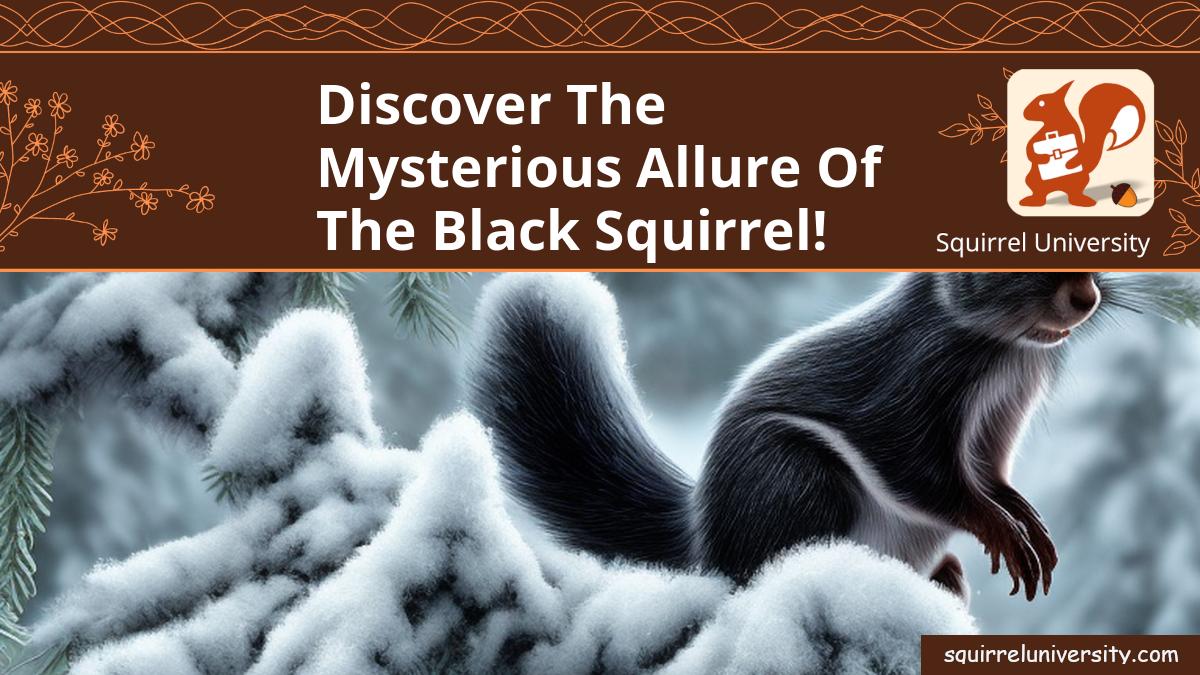I have been fascinated with black squirrels for years, and my travels around the world have only heightened my appreciation for this mysterious melanistic subgroup of North American squirrels. I believe they offer an incredible advantage in colder climates due to their variant pigment gene, yet remain quite a mystery to many. It is time to take a closer look at these special creatures and discover the allure that surrounds them.
Black squirrels are a melanistic subgroup of North American squirrels, such as eastern grey and fox squirrels, distinguished by their black fur. The result of a variant pigment gene, black morphs of these species are believed to offer a thermal advantage in colder climates compared to their lighter-colored counterparts. Black squirrels have also been observed in some European countries, likely as a result of migration from North America.
Black Squirrels: A Closer Look into Their Unique Characteristics
Black squirrels are a mesmerizing sight, with some North American species sporting coat of charcoal-colored fur, otherwise known as melanism. While the phenomenon is not uncommon in other animals such as cats, dogs and birds, it is particularly visible in squirrels, creating an entirely new subgroup for these scurrying critters.
The cause of this unique coat colouration has been attributed to a variant pigment gene that is believed to be responsible for the black morphs of eastern gray (Sciurus carolinensis) and fox squirrels (Sciurus niger). However, over time, the group of alleles (called haplotypes) that included this “black fur” gene variant have likely stopped being identical in the two species.
Appearance and Physical Characteristics
The black squirrel is a rare and alluring sight, with their stunning dark fur radiating an unmistakable mystery. Their unique pigment gene gives them their distinct coloration, making them easily recognizable among other gray morphs of the eastern gray squirrel. This darker fur provides these little critters with an advantage in terms of predation and temperature change resilience. So next time you spot one, take a moment to appreciate the beauty of this wonderful animal!
Distinctive Coat
With regard to black squirrels and melanism, two major theories dominate the literature. The first suggests that its frequency is the result of crypsis – where dark fur is more difficult to detect in dark habitats allowing them to hide from predators better. The second theory proposes that its presence can be attributed to thermoregulation – with darker fur potentially providing a thermal advantage for individuals living in colder climates.
Researches have also suggested that black morphs may be more resilient to predation and temperature changes due to their dark coloration offering a variation on traditional camouflage methods. Studies have also demonstrated how black morphs tend to initiate flight less readily than their non-melanistic counterparts after hearing a red-tailed hawk.
Regional Variations
Groups of black squirrels are predominately found in northern regions of the United States and Canada – although they have also been observed in some European countries like Britain presumably as a result of migration from North America.
Additionally there are several stories involving albino or white squirrels around popular tourist spots like Olney Illinois which tourists from all over visit.In recent years there has even been reports of white or albino south parkers which further adds to the charm and rarity of these unique creatures.
Adaptations
Most special adaptations revolve around those related to their environment. In terms of diet, squirrels rely heavily on nuts and seeds but will also eat insects, eggs and baby birds occasionally. They store food in caches often deep underground or up high in trees depending on preference.
They are also very well adapted at climbing as they possess curved claws – perfect for getting good grip on bark while scaling vertical surfaces! Furthermore, there’s evidence suggesting they can make remarkable jumps with large distances between trees due to their long hind legs.
Habitat and Diet
Natural Habitat
Black squirrels inhabit both urban and rural areas across North America predominantly within deciduous forests where mature hardwood trees grow. In fact it’s not uncommon for these rodents to nest inside hollowed out tree trunks – often referred to as arboreal nests among nature enthusiasts.
To survive wintery conditions squirrels build extensive nests using sticks twigs leaves straw or whatever else can provide insulation from weather– typically located between branches or within hollow trees
Prey
The bulk of an adult squirrel’s diet consists primarily of plant matter such as nuts tree bark fruits fungi flowers etc.; however they’ve also been known to feed off smaller birds and animal carcasses when necessary – lending them an opportunistic omnivorous lifestyle. Insect larvae serve as another source nutrition during summer months when other food sources become scarce.
Interactions with Humans
As humans expand into wilder parts of our planet interactions between these two mammals have become increasingly common; black squirrel populations are sometimes intentionally encouraged near recreational spaces – such as golf courses parks colleges etc– as sort of unofficial mascots if you will.
On occasion people even keep pet squirrels though this tends to raise ethical dilemmas about potential stress levels for wild animals kept under human care; overall it’s best just leave them alone let them do their thing!
Human Encroachment
The allure of black squirrels has led to many attempts at introducing them into new locations, often with unintended consequences. Several populations of black morph squirrels were introduced into the area by accident, but sadly some are still viewed as an invasive species to the local ecosystem – a consequence of human activity.
Thankfully, there have been several positive attempts made in reintroducing and re-populating the black morphs in areas they once inhabited and had been wiped out through human hunting and predators in prior centuries. This grand effort is an ongoing process that involves careful stewardship and habitat conservation efforts.
Uses of Black Squirrels By Humans
Humans often have an appreciation for creatures that are unique. The rarity of black squirrel populations has caused them to become something of an iconic symbol in various countries where they’ve been observed. In Michigan, USA, for example, there are such things as “Black Squirrel Day” events (held yearly) and golf courses named after the species. They also have pubs and bars with their namesake.
In places like England and Scotland, there’s even a European equivalent called the “sooty” squirrel due to it’s charcoal-colored fur. There are also many instances of races or competitions involving black squirrels. For example, in Canada’s Ontario province a popular event “The Great Grey & Black Grouse Race” pits two teams against each other racing the species along a 100 yard course.
Interesting facts & Entertainment Related to Black Squirrels
Yarns, Craft Supplies, Golf Courses, Pubs, Races, etc.
When people think about black squirrels they usually don’t associate them with craft supplies – something usually reserved for more traditional furry creatures like bears or rabbits. At The Black Squirrel however we take pride in offering our customers a wide variety of yarns from unique indie-dyed yarns to non-superwash climate-beneficial yarns to budget friendly and luxury yarns. We believe that every item we stock has been chosen with the utmost care–every yarn and tool is worked with before we bring it in–to make sure that it meets our standards of quality.
But mainly, we wouldn’t be here without our incredible local crafting community: our number one goal is to encourage people everywhere to keep on crafting! Our shop provides a welcoming atmosphere for all regardless of their race, gender identity or orientation — everyone is welcome here! We strive to provide free help when needed as well as host affordable workshops so that people can learn new skills while enjoying some time amongst friends.
FAQ
Where can black squirrels be seen in the United States?
Black squirrels can be found in several locales throughout North America. In the United States they are present in places such as Washington D.C., Ohio, Ontario and Iowa, among others. The black squirrel is a rare species of rodent, comprising only one in every 10,000 of its kind.
What proportion of squirrels have black fur?
Approximately 1% of squirrels are black. This species of squirrel, known as melanistic squirrels, is much rarer than the more common Eastern gray squirrel found in North America. Today, these rare animals can be seen in both the US and Canada – especially Ontario, Washington D.C., Ohio and the UK.
Is it unusual to see a black squirrel?
Black squirrels are not a common sight. In fact, they are quite rare, making up only 1 in 10,000 of the total population of eastern gray squirrels that can be found across parts of the United States and Canada. Historically, these creatures were native to North America but have since been introduced to other countries like the United Kingdom.
How did black squirrels arrive in the United States?
Black squirrels arrived in North America from their native eastern United States and were later introduced to Canada by Thomas W. Gibson in 1902. Today, they can be found in many parts of the U.S., including Ontario, Washington, D.C., Ohio, Iowa, Wisconsin, Minnesota, Maryland and Pennsylvania.
Conclusion
Today, the allure of the mysterious black squirrel still holds strong in many parts of North America and Europe. They have a unique beauty that has captivated curious minds everywhere and are renowned for their ability to withstand extreme temperatures. If you’ve ever encountered a black squirrel out in nature, you understand why they have become a symbol of strength and resilience.
Head out on a journey to discover and admire these beautiful creatures, and you’ll find yourself captivated by the mysterious allure of the black squirrel!
You may also be interested in reading:

